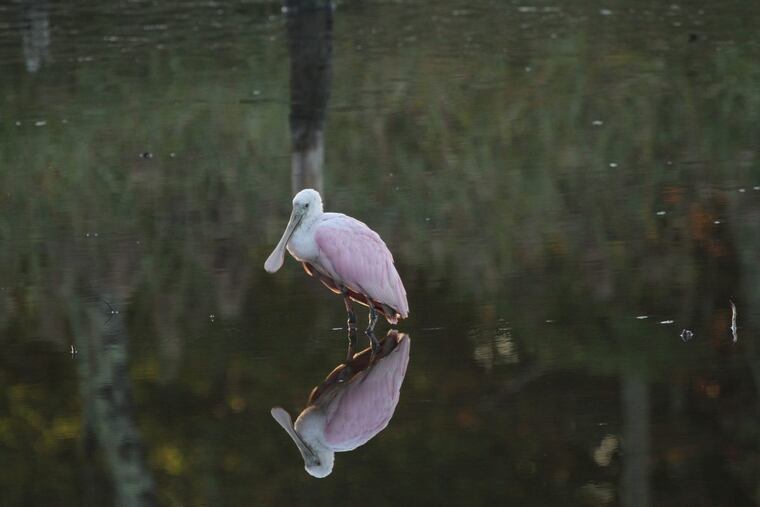Far from home, a pink bird drifts over to South Jersey, and the hurricanes may be to blame
The roseate spoonbill - and other species rare to the region, such as the wood storks sighted near Cape May and the white-winged tern that turned up in Pennsylvania last week - may be harbingers of a slew of unexpected arrivals in this region.

The very minute Janet Crawford noticed on a birding website that a roseate spoonbill — a light-pink wading bird with a beak so dramatic, it looks like a long wooden spoon — had been spotted in a wildlife sanctuary less than a mile from her home in South Jersey, she dropped everything and drove to the site.
"I was there in three minutes," said Crawford, 65, an avid birder for 22 years, who wanted to add the species, rarely found in the mid-Atlantic region, to her "lifetime list" of birds she has spotted near her home in Leesburg, Cumberland County. She regularly scans eBird.com and other websites to see what birders may be viewing in their own neighborhoods.
"I'm a big chicken when it comes to calling rare birds. … I don't want to be wrong about this stuff. So I wanted to get down there and see it for myself, get a good view before I would believe that it is actually here," Crawford said. She and friend Brian Johnson found the bird perched in wetlands on a quiet stretch of Matts Landing Road, which runs alongside the Heislerville Wildlife Management Area.
The pink spoonbill and other species rare in the region, such as the wood storks sighted near Cape May and the white-winged tern that turned up in Pennsylvania last week, may be harbingers of a slew of unexpected arrivals in this region, experts say. They say bird species typically found in more southerly climes that likely are being driven north by weather patterns generated by the monster storms that have ravaged Texas and Florida over the last three weeks.
While it may be impossible to pinpoint exactly why a particular bird ends up in a specific locale so far from its usual range — the roseate spoonbill is usually found in Texas and Florida — some ornithologists are willing to speculate on a cause.
"Birds disperse and migrate over wide temporal and spatial scales, and that is part of their ecology," said Andrew Farnsworth, a bird migration expert at the Cornell Lab of Ornithology in Ithaca, N.Y. But when climate and landscapes change rapidly, causing their populations to decline, they may show up outside their normal range, he said.
Although there have been sightings in New Jersey of roseate spoonbills, the latest in 2009 when they were reported in the Forsythe Wildlife Refuge in Galloway Township and further up the coast near the beach in Sandy Hook, it is still a very rare species to find in this region.
"I think the pink color — which isn't as vivid, of course, as a flamingo — is very exciting for birders to see," said Brett Ewald, program director at the Cape May Bird Observatory, which began last week receiving reports of pink spoonbill sightings. The observatory tracks bird migration patterns and offers lectures, tours, and other support to birders.
Ewald said this particular roseate spoonbill had become an such attraction for birders that the observatory had fielded calls from as far away as California and Canada.
"People seem to be willing to come from all over to see it," Ewald said. "I think it's because no matter how many times you may see a roseate spoonbill, it's always going to be a special thing."
South Jersey, and the Cape May peninsula in particular, is considered among the premier flyways in North America to observe and track bird migration. And the severe storms in the south may drive more species to this region, according to Ewald.
"I think maybe in four or five days, once the full effects of [Hurricane] Irma are felt in terms of habitat and food-source loss, we may begin seeing birds usually found only in the Carolinas, Georgia, Florida, and the deep South finding their way here," Ewald said.
And, he added, "we may just see more of the same species that we have here already. For example, bald eagles or sea birds already here. … There may ultimately be more of them that were storm-driven here."
Ewald said that this did not necessarily spell the end of the line for birds that wind up here, though they may be better suited for other regions.
"We have sporadically seen individuals of particular species in the past that have made migrating through this region — even though that may not be the norm for that particular species — that have very successfully made this a stopover," Ewald said. "For whatever reason it became part of that particular bird's annual migration pattern on its way back to its normal range, so this doesn't necessarily mean any of this could be harmful, which is good news."